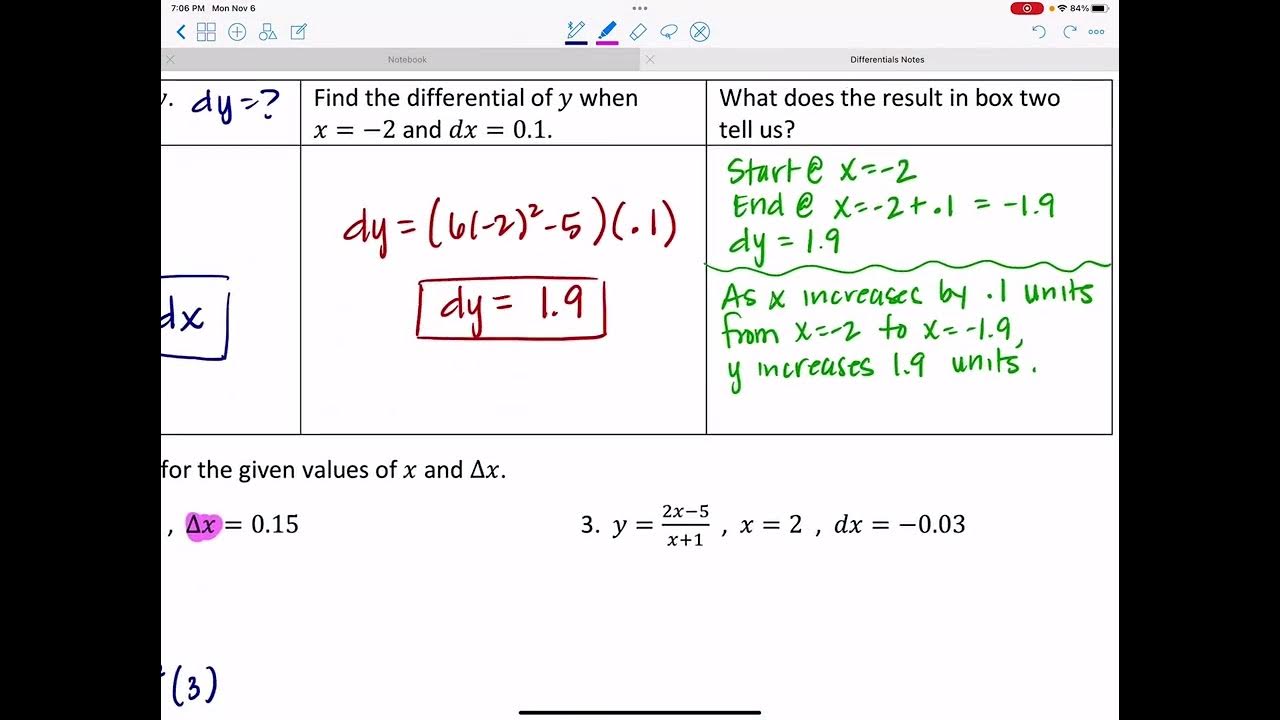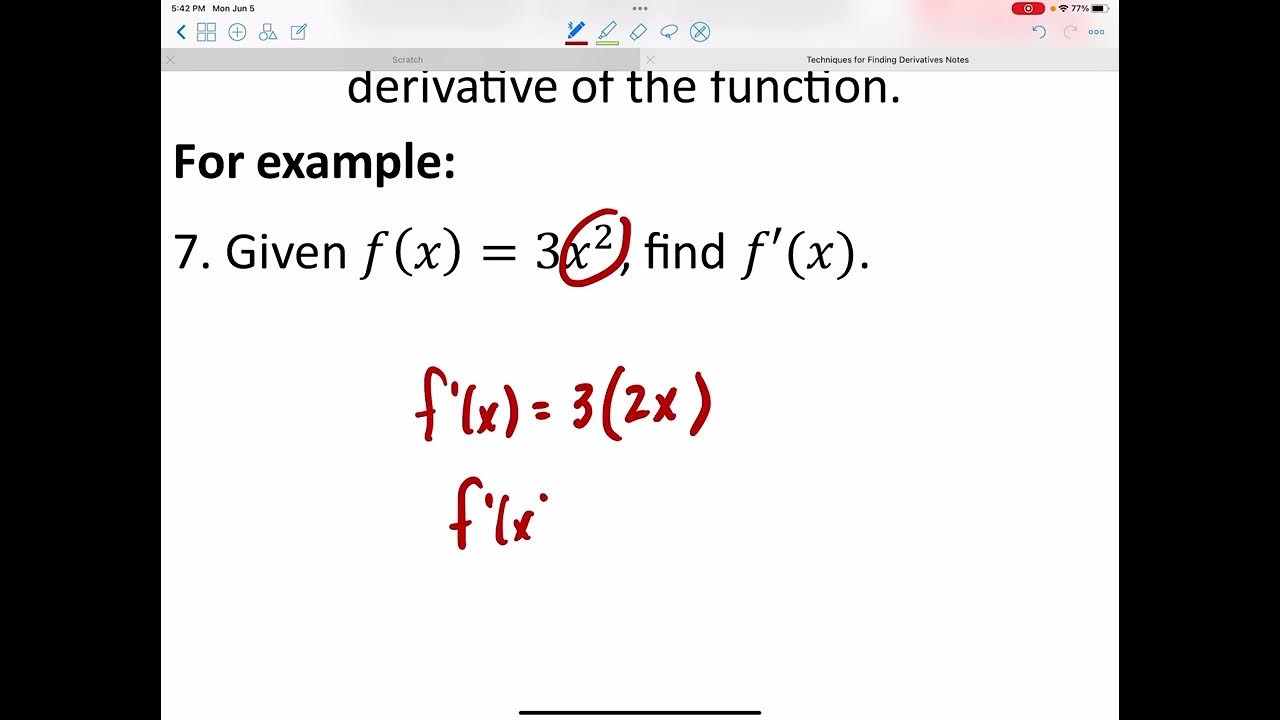Calculus Chapter 2 Lecture 15 Differentials
TLDRIn this calculus lecture, Professor Greist introduces the concept of differentials, exploring their role in understanding rates of change across various fields. He discusses differentials as infinitesimal changes, operators in equations, and their applications in geometry, physics, and economics. Examples include the slope of a tangent line to a circle, marginal rate of substitution in economics, and related rates problems such as the changing cross-sectional shape of a water stream. The lecture also touches on relative rates of change and elasticity in economics, emphasizing the abstract yet practical utility of differentials in diverse applications.
Takeaways
- 📚 Differentials (Dx, Dy, etc.) are used to represent infinitesimals or very small changes in variables, and they are central to understanding rates of change in calculus.
- 🔍 The notation Dx can be thought of as a rate of change, where dU/dx represents the rate of change of U with respect to x, but the full truth involves differential forms which are beyond the scope of single-variable calculus.
- 🔧 Differentials act as an operator, transforming a function f into its differential df, which provides insights into how outputs change with respect to inputs.
- ⚙️ Implicit differentiation is a powerful technique for finding slopes of tangent lines to curves defined by equations like that of a circle, using the differential form of the equation.
- 📈 In economics, differentials help in calculating the marginal rate of substitution (MRS), which is the rate at which a consumer is willing to trade one good for another, assuming fixed utility.
- 💡 The MRS can be derived from a utility function and is expressed as the negative ratio of the differentials dy/dx, providing a quantitative measure of trade-offs between goods.
- 🚰 Related rates problems, such as determining how the cross-sectional shape of a water stream changes, can be solved using differential equations that relate various rates of change.
- 🔌 Differentials are also used in physics and engineering, for example, to relate the relative rates of change of current and resistance in an electrical circuit using Ohm's law.
- 📏 In geometry, the relative rates of change of volume and surface area of a solid, like a ball or a cube, can be compared using differentials, revealing a constant ratio that is independent of the object's size.
- 🛒 Elasticity of demand in economics is related to the relative rates of change of quantity demanded and price, with different elasticity indicating different sensitivities to price changes.
- 📊 Maximizing relative revenue involves understanding the relationship between the relative rates of change of price and quantity, with the optimal condition occurring when elasticity equals one.
Q & A
What is the initial question posed by Professor Greist in the lecture?
-The initial question posed by Professor Greist is 'What is DX?', teasing the audience about a concept they might have been waiting to learn throughout their lives.
What is the intuitive interpretation of differentials such as DX?
-The intuitive interpretation of differentials like DX is that they represent infinitesimals, which are really small bits of X, used in integration to yield the function U.
What is another perspective on what DX might represent?
-Another perspective is that DX connotes a rate of change, where it is related to the rate of change of U with respect to X, as per the chain rule D(U) = D(U/DX).
Why does Professor Greist mention that differentials are not just rates of change?
-Professor Greist mentions that differentials are not just rates of change because they are actually differential forms, a concept that is more complex and not covered in a single-variable calculus course.
What does the operator D do when applied to a function f?
-When the operator D is applied to a function f, it yields the differential df, which provides information about the rates of change of the function's output with respect to its inputs.
How is implicit differentiation applied to the equation of a circle?
-Implicit differentiation is applied to the equation of a circle by differentiating the entire equation, which results in an equation involving the differentials DX and dy, allowing for the calculation of the slope of the tangent line.
What is the marginal rate of substitution in economics, and how is it related to differentials?
-The marginal rate of substitution in economics is the rate at which a consumer is willing to exchange one product for another, assuming a fixed utility. It is related to differentials as it can be expressed as minus dy/DX along a curve of fixed utility.
How can the concept of differentials be applied to related rates problems?
-Differentials can be applied to related rates problems by setting up an equation that relates the rates of change of different quantities, and then differentiating this equation to find the rate of change of one quantity with respect to another.
What is the significance of the equation PI R squared V equals C in the context of a water stream?
-The equation represents the constant flow rate through a cross-section of a water stream, where R is the radius of the stream and V is the velocity. Differentiating this equation helps in understanding how the radius of the stream changes with respect to the velocity.
How are relative rates of change defined, and what do they indicate?
-Relative rates of change are defined as the normalization of the differential, such as D(U)/U, which indicates the percentage change in a quantity and is unitless. They can also be expressed in terms of the natural logarithm of the quantity.
What is the relationship between the relative rates of change of resistance and current in a simple circuit?
-In a simple circuit, the relative rates of change of resistance and current are inversely related, as shown by the equation di/I + DR/R, which results from differentiating Ohm's law and setting the relative rate of change of voltage to zero.
How does the relative change in volume compare to that of surface area for a solid ball?
-For a solid ball, the relative change in volume is always 150% of the relative change in surface area, as demonstrated by the ratio of the relative rates of change, which is a constant value of 3/2.
What is the significance of elasticity in economics, and how is it related to the demand for products?
-Elasticity in economics refers to the responsiveness of the quantity demanded to a change in price. If the elasticity is less than one, demand is inelastic, meaning price changes do not significantly affect the quantity demanded, as is the case with milk. If elasticity is greater than one, demand is elastic, and price changes have a more pronounced effect on the quantity demanded, like with wine.
How is the concept of maximizing relative revenue related to the elasticity of demand?
-Maximizing relative revenue is related to the elasticity of demand because the relative revenue is maximized when the elasticity equals one. This is derived from the relationship between the relative rates of change of quantity demanded and price.
Outlines
📚 Introduction to Differentials in Calculus
Professor Greist introduces the concept of differentials in calculus, starting with the question of what 'DX' represents. He explains that while it's often thought of as an infinitesimal part of 'X', the true nature of differentials is more complex. The lecture hints at differentials as operators that relate to rates of change, as seen in the chain rule 'Du/DX', and their application in implicit differentiation. An example is given using the equation of a circle to find the slope of the tangent line, showcasing the utility of differentials in geometry.
🍩 Economics and Differentials: Marginal Rate of Substitution
The script delves into the application of differentials in economics, specifically the marginal rate of substitution (MRS). It uses a utility function involving coffee and donuts to illustrate how MRS can be calculated using differentials. The example demonstrates the calculation of MRS as 'Y over 2 times quantity X minus 3', showing how the willingness to trade one good for another changes with varying quantities. The paragraph also touches on related rates problems, such as the changing cross-sectional shape of a water stream, and introduces the concept of relative rates of change.
💧 Related Rates and the Shape of a Water Stream
This section explores the concept of related rates, using the example of water flowing from a faucet to discuss how the cross-sectional shape of the stream changes. The script assumes a steady stream and uses the equation 'PI R squared V equals C' to represent the constant flow rate, leading to a differential equation that relates the rate of change of the radius 'R' with respect to velocity 'V' and acceleration due to gravity 'G'. The solution suggests that the radius changes with height in a predictable manner, indicating the stream gets thinner as it falls.
🔌 Relative Rates of Change: Ohm's Law and Elasticity of Demand
The script discusses the concept of relative rates of change, using Ohm's law in a circuit as an example to show the inverse relationship between the relative rates of change of resistance and current. It then extends this concept to geometry, comparing the relative changes in volume and surface area of a solid ball and a cube, revealing a constant ratio. The lecture concludes with an economic application, defining elasticity of demand and showing that the demand for goods like milk (inelastic) versus wine (elastic) responds differently to price changes. The concept of maximizing relative revenue with respect to price change is also introduced.
📉 Elasticity of Demand and Maximizing Revenue
The final paragraph focuses on the economic concept of elasticity of demand, explaining how it measures the sensitivity of quantity demanded to price changes. The script contrasts inelastic goods like milk, where price changes have a minimal effect on demand, with elastic goods like wine, where demand is more responsive to price reductions. It introduces the idea of perfectly elastic demand and uses the formula for elasticity to derive the condition for maximizing revenue, which occurs when elasticity equals one. The lecture concludes by emphasizing the abstract nature of differentials and their usefulness in various fields, promising further exploration in multivariable calculus.
Mindmap
Keywords
💡Differentials
💡Rate of Change
💡Implicit Differentiation
💡Marginal Rate of Substitution
💡Related Rates
💡Relative Rate of Change
💡Elasticity of Demand
💡Maximizing Relative Revenue
💡Infinitesimals
💡Differential Forms
Highlights
Introduction to the concept of differentials, DX, in calculus.
Differentials as infinitesimals, a perspective on their small size.
Differentials as a rate of change, related to the chain rule.
Differentials as differential forms, a more complex concept not covered in single variable calculus.
D as an operator, its role in differentiating equations and implicit differentiation.
Application of differentials in finding the slope of a tangent line to a circle.
Economics application of differentials in substitution rates and marginal rate of substitution.
Utility function example with coffee and donuts to illustrate marginal rate of substitution.
Differentiation of a utility function to find the marginal rate of substitution.
Related rates problems in physics, such as the changing cross-sectional shape of a water stream.
Derivation of the equation relating the radius and velocity of a water stream to its shape.
Relative rate of change, its definition and significance in different contexts.
Ohm's law and its differentiation to find the relationship between resistance and current.
Geometry example comparing relative changes in volume and surface area of a solid ball.
Elasticity of demand in economics and its relation to the relative change in price and quantity demanded.
Maximizing relative revenue by understanding the relationship between price elasticity and demand.
Conclusion on the abstract perspective of differentials and their utility in various domains.
Transcripts
5.0 / 5 (0 votes)
Thanks for rating:





